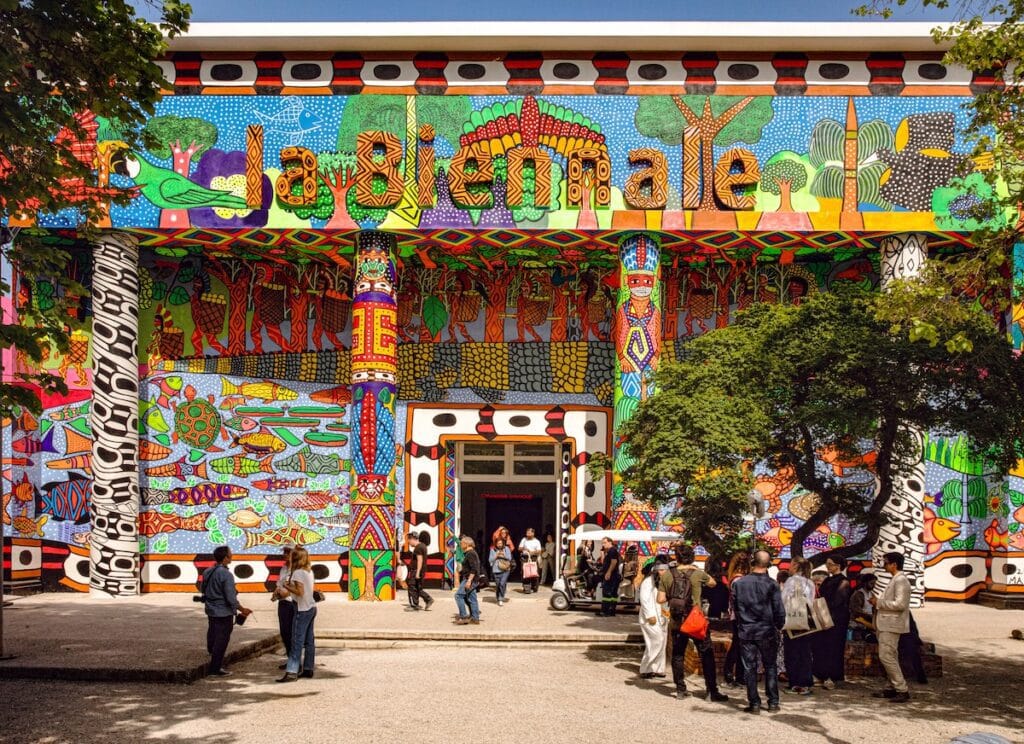🇬🇧 Venice Biennale 2024

Art as Resistance: Venice Biennale 2024 Brings Global Struggles to the Forefront
The 60th Venice Biennale, curated by Adriano Pedrosa under the theme "Foreigners Everywhere," has transformed Venice into a hub of urgent dialogues. This year’s event, one of the most influential in the contemporary art world, addresses critical issues like identity, migration, colonial legacies, justice, and resilience. Reflecting global tensions, from Palestine to Ukraine, the Biennale is filled with artworks that challenge viewers to confront histories and injustices while celebrating resilience and cultural identity.
1. Foreigners Everywhere: The Central Theme
Pedrosa’s choice of theme encourages an exploration of displacement, otherness, and belonging. The title "Foreigners Everywhere" resonates on multiple levels, suggesting that in a world of borders and exclusion, everyone, at some point, is an outsider. Artists from diverse backgrounds use this concept to highlight stories of migration, discrimination, and the intersections of global histories, often drawing on their personal experiences.
2. Palestinian Resistance and Symbols of Struggle
With the intensification of conflicts between Israel and Palestine, references to Palestinian resistance have appeared prominently in the Biennale. Some artists, like those in the Palestinian Pavilion, used subtle yet powerful symbols, such as watermelons—a nod to the red, black, green, and white colors of the Palestinian flag, banned in Gaza and the West Bank after 1967. One piece features watermelons and the phrase "viva Palestina," boldly reclaiming Palestinian identity. The back of this canvas, with an embroidered anatomical heart and the message “Hearts that unite against genocide,” further highlights the resistance and solidarity of Palestinian communities.
3. Indigenous Histories and Colonial Legacies
Indigenous perspectives are woven into many exhibits, shedding light on colonialism’s long-lasting effects. The Australian Pavilion, awarded the Golden Lion for Best National Participation, showcases Archie Moore’s kith and kin, a powerful exploration of the generational impacts of colonization on Indigenous Australians. Through a sprawling family tree and references to his Kamilaroi and Bigambul ancestors, Moore emphasizes the shared history of humankind, including Indigenous struggles and the damage caused by systemic discrimination. Similarly, the Huni Kuin Artists Movement in the Brazilian Pavilion tells ancient myths like kapewë pukeni (the alligator bridge), underscoring the connection between different lands and cultures disrupted by colonialism.
4. Art as Protest: Highlighting LGBTQIA+ Rights and Resistance
LGBTQIA+ themes appear prominently, amplifying calls for justice and visibility. The work of Puppies Puppies (Jade Guanaro Kuriki-Olivo) memorializes the victims of the 2016 Pulse nightclub shooting, emphasizing the persistence of queer resistance. Her A Sculpture for Trans Women..., a life-sized bronze sculpture, celebrates trans life as an act of protest and commemoration. By integrating LED lights in Electric Dress, Kuriki-Olivo also pays tribute to queer and trans lives, boldly challenging erasure and invisibility.
5. Environmental and Social Justice in Latin America
Environmental justice is another recurring theme, particularly in the works of Latin American artists. Daniel Otero Torres addresses ecological crises in Colombia with Aguacero, an installation that speaks to the struggles of marginalized communities impacted by pollution from illegal mining. His work metaphorically explores the journey of clean water, connecting it to global issues of environmental exploitation and privatization.
Additionally, Paraguayan artist Julia Isídrez brings traditional Guarani ceramics into contemporary art. By blending indigenous craftsmanship with modern influences, she creates hallucinatory, baroque pottery that speaks to cultural preservation and adaptation. Her work not only showcases Guarani heritage but also underscores the importance of cultural continuity amidst global pressures.
6. The Impact of Migration: Testimonies of Displacement
Migration narratives resonate deeply across various pavilions. Anna Jermolaewa, representing Austria, uses her past as a political refugee to illustrate stories of nonviolent resistance and the experience of living between worlds. Her work reflects the trauma of displacement, with pieces like Research for Sleeping Positions, which reenacts her early experiences in Vienna as a refugee. Similarly, Ukrainian artists convey the toll of war and displacement, with installations that invite audiences to witness and empathize with the struggles of civilians forced to leave their homes.
7. Breaking Boundaries with Gender and Identity
Mexican artist Bárbara Sánchez-Kane presents Prêt-à-Patria, a subversive exploration of Mexican masculinity. Using military symbolism and fashion, her work critiques nationalistic fervor and gendered power structures, blending masculine and feminine clothing to challenge traditional identities. The provocative nature of her work highlights the constraints of social norms and the fluidity of identity, making it one of the more memorable installations this year.
A Final Reflection: Art as a Bridge to the Future
The Biennale does more than showcase art; it builds bridges across histories, geographies, and struggles, reminding audiences of shared human kinship. Through varied expressions—from Indigenous wisdom and Palestinian symbols to LGBTQIA+ advocacy—this year’s Biennale reflects art's power to confront, commemorate, and create connections. In many ways, it’s a call to action, urging audiences to recognize the universality of struggle and the importance of solidarity.
The 60th Venice Biennale has become a powerful mirror reflecting global crises, social injustices, and shared humanity. With "Foreigners Everywhere" as its guiding theme, the event transcends mere aesthetics, calling for awareness, empathy, and collective action. It captures the zeitgeist of our times, where borders blur, histories intersect, and art becomes both a witness to and an agent of change. In Venice, artists have transformed their pavilions into spaces of remembrance, resistance, and hope, making this Biennale not only a celebration of art but a testament to resilience in an increasingly fragmented world.

